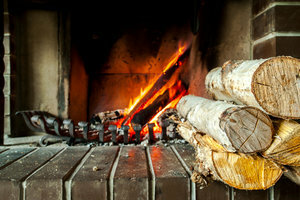Firewood and its calorific value
A fire in the fireplace creates a homely feeling on cool evenings. Nothing is cozier than when the firewood crackles and spreads a pleasant smell in the room. However, every type of wood has its own individual properties. How it burns, keeps the embers and how it heats depends entirely on its calorific value, which you should know.

General information about firewood
- There is a large selection of firewood: You can bring cozy warmth into the house with almost all local types of wood. However, spruce, fir, beech, birch, pine and co. Differ considerably in their properties such as shape, color or density. As a fireplace owner, you will probably also attach particular importance to the flying sparks, the smell, the flame pattern and especially the calorific value. This means the thermal energy that each type of wood gives off when it is burned.
- But before you can light the fireplace, the firewood must be well-seasoned so that it can give off its optimal calorific value. Because among the different types of wood there are some that do not dry as quickly due to their high density. Others, on the other hand, have only a low density and hardly store any moisture. The water content of the wood is only reduced if it is stored in an airy and dry place at the correct distance from the floor and wall.
The types of wood and their calorific value
Are you the enviable owner of a fireplace or stove? Congratulations. So you can spend cozy winter evenings or cozy tea hours in front of a crackling, flickering fire. Provided that the calorific value is correct.
- In addition to ash and beech, fireplace owners also swear by oak as firewood. With these hardwoods, the calorific value per cubic meter is 2100 kilowatt hours. As a rule, these types of wood burn with a pleasant room scent without noteworthy flying sparks and cracking noises and are therefore also recommended for an open fireplace. They burn particularly long with a quiet flame, but have to be stored for two years before they are suitable for use in chimneys.
- Followed by maple, chestnut, elm and birch, which have a value of 2000 to 1900 kilowatt hours. The birch in particular is characterized by its essential oils in the resin scent and bluish flame and is also much cheaper than the others mentioned. Since even the birch bark catches fire quickly, it can be used for lighting.
With the expensive energy costs, heating with firewood or Firewood for a ...
- In contrast, the calorific value of coniferous wood such as larch and pine is in the medium range with 1700 kilowatt hours. Like all softwoods, this firewood also attracts attention with its pleasant resin scent and emits the typical cracking noises when burning, which many people find romantic. The spark formation is correspondingly high. On the other hand, the price for pine wood is not that high and you can also buy larch as fresh wood, as it quickly loses its moisture and does not have to be stored for that long.
- Poplar, willow, fir and spruce are only partially suitable for the fireplace because of the strong spark formation and the low heating output of 1500 kilowatt hours. They develop a lot of heat within a short time, but burn off quickly, so you often have to get up to add wood.
But if you don't want to do without the resinous smell and the atmospheric crackling of the firewood, you can Mixing softwoods with hardwoods will light up the fireplace quickly and can be in front of a crackling fireplace with a high calorific value sit.
How helpful do you find this article?


